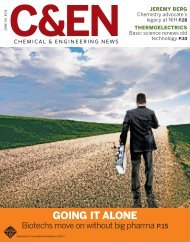Chemical & Engineering News Digital Edition - Institute of Materia ...
Chemical & Engineering News Digital Edition - Institute of Materia ...
Chemical & Engineering News Digital Edition - Institute of Materia ...
You also want an ePaper? Increase the reach of your titles
YUMPU automatically turns print PDFs into web optimized ePapers that Google loves.
A second program seeks to overcome<br />
some <strong>of</strong> the more virulent bugs by inhibiting<br />
bacterial DNA replication, the organism’s<br />
means <strong>of</strong> reproducing and sustaining<br />
an infection. Replidyne has identified a series<br />
<strong>of</strong> compounds that inhibit replication<br />
and hopes to select one IND candidate by<br />
the end <strong>of</strong> the year.<br />
Cubist, with one successful drug under<br />
its belt, is probably in the best position<br />
among the small biotechs to move beyond<br />
the natural products approach and into<br />
novel drug discovery techniques. The<br />
company is incorporating computational<br />
chemistry, chemoinformatics, and structure-based<br />
drug design into R&D.<br />
AT THE SAME TIME, Cubist continues<br />
to exploit compounds found in nature by<br />
improving known drugs and isolating new<br />
compounds that could be engineered into<br />
drugs. That effort is aided by better assays<br />
that can weed out the known antibiotics<br />
that tend to dominate natural product<br />
samples.<br />
Cubist’s Metcalf believes the way forward<br />
is to figure out how to create new libraries<br />
that take into account the differences between<br />
bacterial cells and human cells. Fragment-based<br />
drug design isn’t biased to any<br />
particular type <strong>of</strong> target, he notes, and can<br />
be a starting point to using structural knowledge<br />
to advance a molecule into a drug.<br />
However, substantial resources will be<br />
required to incorporate new techniques<br />
into antibiotics drug discovery. Usually,<br />
that kind <strong>of</strong> money comes only from big<br />
pharma. Pfizer, which bolstered its antibiotics<br />
capabilities in 2005 through the<br />
acquisition <strong>of</strong> Vicuron Pharmaceuticals, is<br />
one <strong>of</strong> the few major companies with substantial<br />
activities in the area.<br />
Although Pfizer’s lead compound, dalbavancin,<br />
belongs to the same class as vancomycin,<br />
the company is also trying to bring<br />
new technology to bear on antibiotic development.<br />
“I think there’s now opportunity<br />
to marry some technologies,” says Paul S.<br />
Miller, head <strong>of</strong> antibacterials research at<br />
Pfizer. In recent years, researchers have<br />
been able to get at new organisms, such as<br />
those dwelling at the depths <strong>of</strong> the ocean or<br />
at extreme temperatures. Simultaneously,<br />
scientists are beginning to understand how<br />
to use genomic tools to manipulate the<br />
genes <strong>of</strong> an interesting organism to tweak<br />
and improve the molecules it produces.<br />
Furthermore, scientists can revisit the<br />
sample libraries accumulated in decades<br />
past—the stuff found in the backyard, as<br />
Miller puts it—and apply new techniques to<br />
find interesting molecules. Many times, only<br />
a tiny fraction <strong>of</strong> what was contained within<br />
those soil samples could be cultured, he<br />
notes. Today, the potential exists for using<br />
genome DNA amplification technology to<br />
fish out genes responsible for assembling a<br />
compound. Those genes can then be cloned<br />
in a laboratory organism to determine<br />
WWW.CEN-ONLINE.ORG 19 APRIL 14, 2008<br />
whether it could make an interesting drug.<br />
“The microbial diversity on the planet is<br />
enormous, and we’ve only been able to characterize<br />
the tip <strong>of</strong> that iceberg,” Miller says.<br />
Interest from big pharma does appear<br />
to be percolating: Merck has several programs<br />
in the early stages <strong>of</strong> development;<br />
GSK is reportedly active in the area; and<br />
Johnson & Johnson has partnered with the<br />
The Must-Have Catalog<br />
Over 2,000 USP/NF/FCC grade chemicals and DEA<br />
controlled substances – the industry’s most<br />
comprehensive collection.<br />
Our Integrated Quality SM program is based on industry-standard best<br />
practices: cGMP, ISO and governmental regulations plus enhanced<br />
testing, documentation and change control. The result: a quality<br />
product with documentation to simplify your compliance efforts.<br />
Products are also available from VWR International, ThermoFisher Scientific,<br />
Regional and International distributors. Order your FREE catalog today.<br />
www.spectrumchemical.com • 800.813.7782<br />
REQUEST MORE AT ADINFONOW.ORG

















